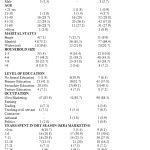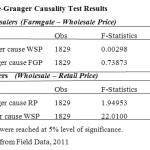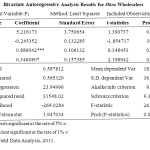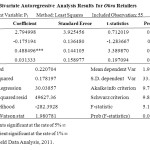Introduction
Nigeria has an agrarian economy and agriculture is the main stay of the economy providing employment to over 90 percent of the rural dwellers who constitute about 70 percent of the total population, through agricultural output production, processing, packaging and marketing (Ademiluyi et al., 2011).
Okra is an important fruit vegetable crop which belongs to the genus Abelmoschus, and family Malvaceae. It has two main species: Abelmoschus esculentus (L.) Moench. and Abelmoschus caillei (A. Chev.) Stevels (Siemonsma, 1982; Anuebunwa, 2007). It originates probably from East Africa and widely distributed in the tropics, subtropics and warmer portions of the temperate region (ECHO, 2003). It features prominently in the vegetable market in the Southeastern Nigeria (Agbugba & Nwagbo, 2006).
Worldwide production of Okra is estimated at 6 million tonnes per year. In West Africa, it is estimated at 500,000 to 600,000 tonnes per year (Burkil, 1997). In Nigeria, there are two distinct seasons for Okra, the peak and the lean seasons. During the dry or lean season, Okra fruit are produced in low quantities, scarce and expensive to get (Bamire & Oke, 2003; Adebisi-Adelani,et al., 2011).
Marketing of Okra during the dry season especially between November and March is complex due to its perishable and seasonal nature as well as its bulkiness. Okra marketing is a very vital component of fruit vegetable industry and there is therefore, a need to move from undeveloped marketing of Okra to a more viable way of marketing them to specified requirements of variety, size, colour, flavour, moisture content, packaging and seasonality (Hosmani, 2007). The marketing of dry season Okra is gradually developing as many people develop interest to engage in the enterprise as market intermediaries thereby, assisting in the process of distribution. Proper marketing of Okra is necessary to arrest wastage being experienced during the dry season period (Farinde et al., 2007).
Dry season Okra marketing is beset with a lot of challenges and constitutes a bottleneck to its fresh flow in the market due to poor flow or movement of market information amongst the marketers (Adebisi et al., 2011). It therefore, hinders the traders from making better decisions pertaining to the viability of seasonal storage of Okra vegetable. Damages occur and are relatively higher when the vegetable is bought due to lack of market information (Agbugba, 2012). In order words, efficient market information will provide accurate market data when analyzed. It will also give positive benefits to farmers, marketing intermediaries and policy makers (Andrew, 1997). Market integration during the dry season period will be measured so as to confirm the movement of price and market information within and between markets.
The measurement as well as the pricing of Okra vegetable in the market poses a constraint due to lack of a standard or uniform measure used in its sale. Enete (1999) noted that marketing system performs vital functions, one of which is the allocation of resources through the pricing system. Prices are important signals which producers and marketers respond to easily in the economic system (International Institute for Food and Policy Research Institute, 2008). Price discrepancies and differences among Okra marketers are very negligible. However, in few cases of differences in its wholesale prices of Okra, due to transparence in market information supply (Agbugba, 2012).
In spite of the constraints encountered in dry season Okra marketing, little research has been done on its marketing in Southeastern Nigeria. Okoh & Egbon (2005) discovered from their study on integrating the Nigeria’s rural and urban foodstuff markets that there are too many intermediaries and high cost of transportation, as well as sources and validity of price data. An important observation is that while markets have characteristics of perfect competition, the price correlation results show that they are not integrated. Dittoh (1994), discovered from his study on market integration in dry season vegetable marketing in Northern Nigeria, that there is poor flow of information in the channel of marketing and that there is need to develop the marketing processes in the enterprise. However, this study (i) described the socio-economic features of dry season Okra marketers in south eastern Nigeria; (ii) determined the price causality in the marketers’ prices of dry season Okra; and (iii) measured the extent of market integration amongst dry season Okra markets.
Material and Methods
The study was conducted in south eastern Nigeria. Out of the five states which make up Southeastern Nigeria, Abia, Imo and Enugu were randomly selected for the study. The area is situated east of River Niger covering an area of 29,908 sq km with population of 16,381,729 (National Population Commission, 2006) and lying on latitudes 50 and 70 75/ North and longitudes 60 85/ and 80 46/ East (Federal Ministry of Lands, Housing and Urban Development, 2010). About 70% of the total population are peasant farmers cultivating arable crops and vegetables, few dealing on cash crops like oil palm and cocoa (Nya, Okorie & Eka, 2010). The Southeastern states have contiguous characteristics in relation to vegetable farmers, as well as marketers and engage predominantly in production and marketing activities of selected indigenous vegetables (especially Okra) during the dry season.
Primary source of data was used for this study. Primary data was obtained through the use of structured questionnaires administered to the respondents. Two agricultural zones were selected from each of the three (3) Southeastern states making it six agricultural zones in a whole. Two markets were randomly selected from a list of major markets from the two agricultural zones previously selected. This gave a total of twelve markets. Ten dry season Okra marketers were randomly selected from each of the markets, except one market where nine marketers (i.e. 4 wholesalers and 5 retailers) were randomly selected for the study. In all, a total of thirty eight marketers each were randomly selected from Abia and Imo states, whereas thirty five marketers were chosen for Enugu state. This gave a total sample size of 111 respondents for the study.
Analytical Techniques
Descriptive statistics such as frequencies and percentages were used to describe the socio-economic characteristics.
Granger Causality Model
This model was used to determine the price causality in the marketing of dry season Okra
∑FGPt = ∑aWSPt + ∑bFGPt-1 + U1t
∑WSPt = ∑cWSPt-1 + ∑dFGPt + U2t
∑WSPt = ∑eRPt + ∑fWSPt-1 + U3t
∑RPt = ∑gWSPt + ∑hRPt-1 + U4t
Where
FGPt = Farmgate price at time (t)
FGPt = Farmgate price at time (t-1)
WSPt = Wholesale price at time (t)
WSPt-1 = Wholesale price at time (t-1)
RPt = Retail price at time (t)
a, b, c, d, e, f, g and h are parameters to be estimated
The error terms U1t, U2t, U3t and U4t are assumed uncorrelated (Granger & Newbold, 1977).
Causality relationships which were tested using the F-Test for statistical significance are applicable placing appropriate restrictions on the model. The result of the analysis took the underlisted forms:
(a) Unidirectional causality (either from WSPt to FGPt or from FGPt to WSPt or from WSPt to
RPt or RPt to WSPt)
(b) Independence causality i.e. no causality.
(c) Bilateral causality also known as feedback causality.
Bivariate Autoregressive Model
The Dynamic Spatial and Temporal Market Model was adopted to measure the presence and extent of integration between the market pairs of dry season Okra markets in a short term period of 2 months or 61 days in the study area. Mendoza & Rosegrant’s (1995) model for cassava roots or gari were specified as follows:
ΔRit = αo + Δ Rit-1 + boΔPjt + b1ΔPjt-1 + e
Where:
ΔRit = the contemporaneous (short term) price changes in Central or Leading market i for
dry season Okra
ΔPjt = the contemporaneous (short term) price changes in Local market j for dry season Okra
(i=j);
boΔPjt = included to capture any instantaneous change in Pit as Pjt changes ΔPit-1 and
ΔPjt-1 = large price changes in Central or Leading and Local markets i and j respectively.
αo and bi are parameter estimates
e is the error term
F-statistics was used to test the pricing behavior of dry season Okra markets.
If b1 = 0, the markets are not integrated, they are independent in pricing.
If b0 = 1, b1 = α0 = 0, there is instantaneous adjustment to price changes in the markets, and the markets are perfectly competitive.
If b0 = 1, b1 + α0, there is perfect price matching in unorganized markets where response to price changes among groups of traders is delayed.
Results and Discussion
Socio-Economic Features of Dry Season Okra Marketers
The socio-economic features of Okra wholesalers and retailers considered in this study include: sex, age, marital status, household size, level of education, occupation and number of years spent in marketing of dry season Okra.
Females were the key players comprising 94% of the wholesalers and 100% of the retailers in the dry season marketing of Okra. This implied that improvement in infrastructure and marketing operations, processing as well as production, females will first of all benefit, followed by their husbands, families, communities and consumers. Furthermore, the exceptional roles women perform in making fresh Okra available to the final consumer are crucial and oftentimes interwoven. However, for anyone interested in rural women’s welfare, Okra marketing offers an important entry point. These vegetables provide an important economic pillar upon which women’s rural livelihood is supported. Production, handling and marketing are mostly done by women. Out of the 111 Okra marketers interviewed during the survey, only three respondents were noted to be males. Okra wholesalers (39%) and retailers (36%) fell within the age bracket of 31-50 years. Schippers (1998) carried out a study on indigenous vegetable in a sub Saharan African country, and established that the ages of key market players in Okra marketing fell between 25 and 45 years of age. This implied that dry season marketers of Okra were in their active productive age, a good indication for sustainable and active marketing of dry season Okra in the study area. The percentage of marketers that are married were wholesalers (73%), and 65% for retailers. It is believed that the married marketer who engages in marketing of agricultural products tend to be more stable than the single (Agbugba et al., 2013). Household sizes were generally larger among the Okra wholesalers and retailers, where 84% and 80% have between 4 and 9 people in their families. This implies that most of the marketers were of child-bearing age between 31 and 40 years old. A majority (49%) of the respondents had formal education through secondary school, 35% had primary education, 11% had tertiary education, while 5% of the respondents had no formal education.
A majority of Okra wholesalers and retailers, 84% and 93% respectively were primarily (full-time) engaged in dry season marketing, while 16% were part-time marketers. Seven per cent were engaged in teaching/civil service, 4% were involved in trading of other commodities, 1% were involved in farming activities as producers, while 1% were involved in artisanal works. Okra marketing during the dry season is a major occupation, and draws many women into its marketing processes and operations.
 |
Table 1: Distribution of Socio-Economic Features of Dry Season Okra Marketers. Click here to View table |
Pairwise-Granger Causality Results
The Granger causality test is a veritable and effective economic tool to forecast, discover and determine where prices are formed in a marketing channel. Locus of price discovery on the other hand, is not only uncertain, but is likely to be changing over time depending on the outcome of price causality tests. It helped economically analyse the efficiency and competitiveness of the dry season Okra markets, with respect to which marketers causes a change in price, i.e. if there is variability in price. Table 2 gives the results of the test:
 |
Table 2: Pairwise-Granger Causality Test Results. Click here to View table |
Okra Wholesalers: Farmgate – Wholesale Price Causality
Results of the Granger causality test between Okra farmgate and wholesale prices indicated a weak relationship between the present and the past values. Using F-statistics at the same decision rule of 0.05 ∞, we accept both hypothesis (FGP does not granger cause WSP, and WSP does not granger cause FGP), and concluded with 95% confidence that there appears to be no price causality relationship existing between WSP and FGP amongst Okra wholesalers. This outcome suggests that price changes are not determined by the market players.
Okra Retailers: Wholesale – Retail Price Causality
Results from the test between Okra wholesale and retail prices indicate an inter-relationship between their present and past values. The F-statistic probabilities indicate that using a decision rule of 0.05 ∞, the second hypothesis that WSP does not granger cause RP is more likely to be rejected than the first hypothesis that RP does not granger cause WSP. This implies that there is a unidirectional price causality relationship existing between Okra wholesale and retail prices. In order words, there is no price causality relationship existing from Okra RP to WSP. This hypothesis may therefore be accepted. We can then conclude with 95% confidence that there is a one-way price causality relationship (unidirectional causality) from WSP to RP for Okra retailers. This implies that Okra wholesalers caused a change in price in Okra retailers’ market. Zellner (1979) made a similar observation.
Market Integration in Dry Season Okra Markets
The study used short term (daily) data collected for 61 days during dry season period of rural (Pi) and urban (Ri) composite Okra price indices, as well as influence of changes in leading market price and changes in local market price indices (ΔRit-1 and ΔPjt-1).
The perfectly competitive market condition is said to be the ideal market structure for market integration, given its attributes that ensure that prices adjust instantaneously to any new information. The concern of market integration analysis is to determine the possibility of obtaining some gains by trading across dry season Okra markets, exploiting price movements in one market (urban) for the prediction of price movements in another market (rural) of the vegetable type (i.e. Okra market).
The dynamic spatial and temporal market model or bivariate autoregressive model was the basic approach adopted for testing the presence and level of integration in pairs of spatially dispersed dry season Okra markets.
 |
Table 3: Bivariate Autoregressive Analysis Results for Okra Wholesalers. |
 |
Table 4: Bivariate Autoregressive Analysis Results for Okra Retailers. Click here to View table |
Table 3 shows there was integration between the central and local markets for Okra wholesalers. These results confirm that price changes in central markets such as: Ochendo (Good morning), Field, Eke-Onunwa, Orie-Okporo, Akwata and Agbani market immediately causes a change in the local markets (Cemetry, Umuahia Main, Eke-Onunwa, Orie-Okporo, Artisan and Ogige). This result implies that at 1% level of significance, integration occurred amongst the market pairs at 65% price adjustment. This high degree of market integration could be attributed to the short distances between the local and central markets, as well as between the distribution channels of Okra wholesalers. These central markets serve as terminal markets for nearby local markets covered during the study.
From Table 4, at about 18% adjustment of price of Okra at the retail end, integration occurred amongst the market pairs of central and local markets at 10% or 0.1 level of significance. In order words, the law of one price holds for Okra market system at the retail end, and so, the retail markets are integrated albeit moderately. This suggests that if factors that make for efficient market of Okra at the retail end, such as improving or subsidizing cost of infrastructure, for example repair of worn out roads and reduction of cost of transporting the products is improved upon, there will be increase in the level of integration in Okra retail market.
Conclusion
Okra features prominently as a major vegetable traded in south eastern Nigeria during the dry season. The market players involved in its marketing during the dry season period include: producers, wholesalers, retailers, commission agents and final consumers. Since the marketing are mostly done by women, Okra marketing offers an important entry point for women. These vegetables provide an important economic pillar upon which women’s rural livelihood is supported. Granger causality test conducted showed that there was no causality relationship existing between the farmgate and wholesale prices for Okra wholesalers; and a unidirectional price causality relationship existing from the wholesale price of Okra and retail price, and not the other way. Bivariate autoregressive model (a.k.a. dynamic spatial and temporal market model) was used to measure integration between central and local markets. From the study, it was ascertained that there was significant relationship between the central and local market prices for Okra wholesalers and retailers. From the result, it showed that there is an instantaneous adjustment to price changes in the market pairs of the marketers, an indication of perfect competitiveness amongst them, suggesting the existence of non-collusive pricing arrangement.
Recommendation
Due to the huge supplies of Okra vegetable from the north, government should also embark on the construction of railways linking the northern regions of the country to the southeastern states. This will drastically reduce the pressure of traffic on the roads. Also, programmes that will improve the knowledge and education of the women should be embarked upon. Causality test conducted showed that there was no causality relationship existing between the farmgate and wholesale prices for Okra wholesalers; and a unidirectional price causality relationship existing from the wholesale price of Okra and retail price, and not the other way.
In order words, it was ascertained that there was a significant relationship between the central and local market prices for Okra wholesalers and retailers. From the result, it showed that there is an instantaneous adjustment to price changes in the market pairs of the marketers, an indication of perfect competitiveness amongst them, suggesting the existence of non-collusive pricing arrangement in the market studied.
Acknowledgements
The author wish to express gratitude to Prof. Noble Nweze and Prof Anthonia Achike of the University of Nigeria for the supervisory role they played during the course of carrying out the research work. Special thanks go to Dr. Henry Bahn of the United States Department of Agriculture for all the morale support which he exhibited in the development of this paper. Finally, I wish to return profound thanks to God, for all the wisdom, knowledge and understanding He displayed in the course of writing this paper.
References
- Adebisi-Adelani, O., Olajide-Taiwo, F.B., Adeoye, I.B. and Olajide-Taiwo, L.O. Analysis of Production Constraints Facing Fadama Vegetable Farmers in Oyo State, Nigeria, World J. of Agric Sciences, 7 (2): 189-192 (2011).
- Adeboye, O.C. and Oputa, C.O. Effects of galex on growth and fruit nutrient composition of Okra (Abelmoschus esculentus). Ife J. of Agriculture, 18 (1 & 2), 1-9 (1996).
- Ademiluyi, I. O, Umar, A. G. and Mbah, A. A. Sustainable Cassava Marketing in Mangu Local Government Area of Plateau State. In: Policy and Agricultural Development in Nigeria: Challenges and prospects by Odedina, et al. (Eds) Proceedings of the 25th Farm Management Association of Nigeria (FAMAN) Conference on 5th – 8th September, 2011, pp 96-101 (2011).
- Agbugba, I.K. and Nwagbo, E.C. The performance of vegetable production and marketing in Aba Area, Abia State, Proceedings of Agricultural Society of Nigeria Conference, Umudike, pp 133-136 (2006).
- Agbugba, I.K. Economic analysis of marketing of dry season vegetable in south eastern Nigeria, Ph.D Research Findings Seminar presented to the Department of Agricultural Economics University of Nigeria Nsukka on May 24th 2012 (2012).
- Agbugba, I.K., Nweze, N.J., Achike, A.I. and Obi A. Market Structure, Conduct, Channel and Margin of Dry Season Okra Vegetable in South-Eastern Nigeria; Presented and Published in the International Conference on Food and Agricultural Sciences, IPCBEE Vol. 55 pp 73-78.
- IACSIT Press, Singapore DOI:10.7763/IPCBEE.2013.v55.14 (Available online at http;//www.iacsitp.com )(2013).
- Andrew. W. S. Market information services theory and practice, FAO Agricultural Services Bulletin 125, Italy, Rome (1997).
- Anuebunwa, F.O. (2007). Structural characteristics of the market for fresh Okra in Ebonyi State of Nigeria, Proceedings of the 41st Conferences of the Agricultural Society of Nigeria, Samaru, pp 489-492.
- Bamire, A.S. and Oke, J.T. (2003): Profitability of vegetable farming under rainy and dry season production in Southwestern Nigeria. J. of Vegetable Crop Production, 9: 11-18.
CrossRef - Burkill, H.M. (1997). The useful plant of West Tropical Africa. 2nd Edition. Vol 4, families M-R, Royal Botanic Gardens, Kew. United Kingdom.
- Dittoh, J .S. (1994). Market Integration: The case of dry season vegetable in Nigeria, Issues in African Rural Development, 2:89-101.
- ECHO. Plant information sheet, N. FT. Meyers, USA. retrieved from: http.www.echonet.org (2003)
- Enete, A. A. The performance of plantain marketing in south-east Nigeria. A SeminarPaper, Department of Agricultural and Environment Economics, K. U. Leuven, Belgium (1999).
- Farinde, O.K. Owolarafe and O.I. Ogungbemi. “An overview of Production, Processing, Marketing and Utilisation of Okra in Egbedore Local Government Area of Osun State, Nigeria.” Agricultural Engineering International: the CIGRE Journal. Manuscript No. MES 07 002. Vol. 4 (2007).
- Federal Ministry of Lands, Housing and Urban Development. Geographical location of southeastern Nigeria, FMLHUD (2010).
- Granger, C. W. J. and Newbold, P. Forecasting economic time series, Academic Press. NewYork (1977).
- Hosmani, R. Vegetable seed marketing in Belgium District an analysis of market structure and farmers preferences,(An Unpublished MBA (Agribusiness) Thesis in Department of Agricultural Marketing, Co-operation and Agribusiness Management), University of Agricultural Sciences, Dharwad, Belgium (2007).
- International Institute for Food and Policy Research Institute. ”High food prices: the what, who and how of proposed policy actions,” Policy Brief (May 2008), Washington DC. IFPRI (2008).
- Mendonza, M.S. and Rosegrant, M.W. “Pricing conduct of spatially differentiated markets”. In: Scott, G.J. (ed.). Price, products and people analysing agricultural and developing countries. Boston: Lynne Rienner Publishers, Inc., USA (1995).
- National Population Commission. Population Figures, NPC, Abuja FCT (2006).
- Nya, E.J., Okorie, N.U. and Eka, M.J. An Economic Analysis of Talinum triangulare (jacq.) Production/Farming in Southern Nigeria. Trends Agric. Econ., 3: 79-93. Available in http://scial ert. net/abstract/?doi=tae.2010.79.93 retrieved on 15th August, 2011 (2010).
- Okoh, R. N. and Egbon, P.C. The integration of Nigeria’s rural and foodstuffs markets, African Economic Research Consortium, Research Paper 151, Nairobi, Kenya, pp 1-34 (2005).
- Schippers, R.R. African Indigenous Vegetables. An overview of the cultivated species, Natural Resources Institute/ACP-EU. Technical Centre for Agricultural and Rural Cooperation (CTA), Chatham, U.K (2000).
- Siemonsma, J.S. The cultivation of Okra (Abelmoschus spp), tropical fruit vegetable (with special reference to the Ivory coast). Department of Horticulture Thesis, Wageningen Agricultural Wageningen, The Netherlands. pp 297 (1982).
- Zellner, A. “Causality and econometrics,” Carnegie-Rochester Conference Series on Public Policy, Elsevier, Vol. 10 (1), pp 9-54 (1979).
